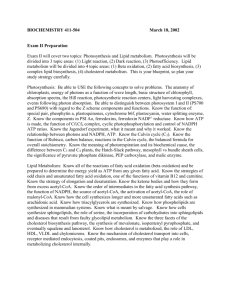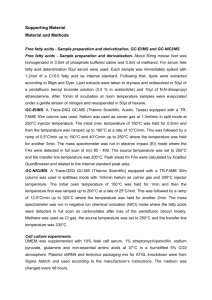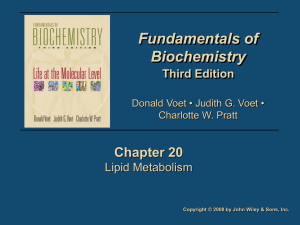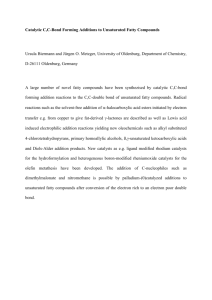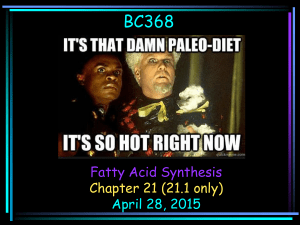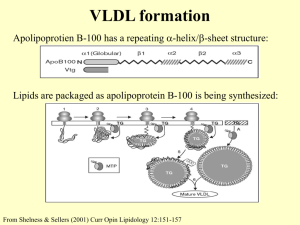FCH 530 Homework 1
advertisement
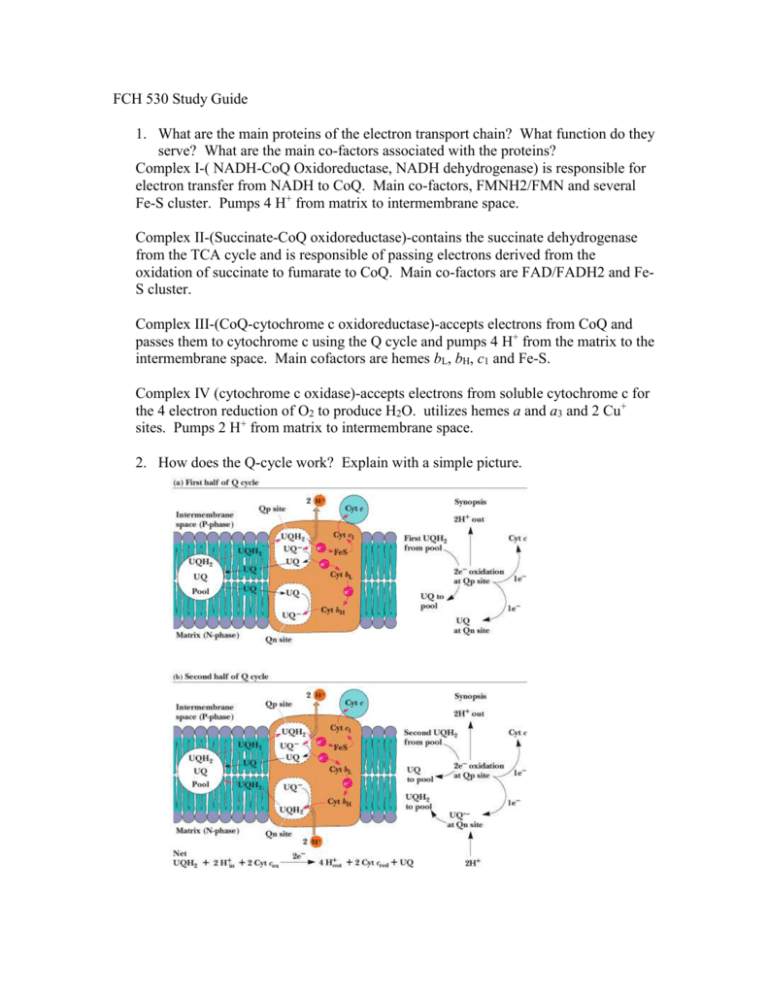
FCH 530 Study Guide 1. What are the main proteins of the electron transport chain? What function do they serve? What are the main co-factors associated with the proteins? Complex I-( NADH-CoQ Oxidoreductase, NADH dehydrogenase) is responsible for electron transfer from NADH to CoQ. Main co-factors, FMNH2/FMN and several Fe-S cluster. Pumps 4 H+ from matrix to intermembrane space. Complex II-(Succinate-CoQ oxidoreductase)-contains the succinate dehydrogenase from the TCA cycle and is responsible of passing electrons derived from the oxidation of succinate to fumarate to CoQ. Main co-factors are FAD/FADH2 and FeS cluster. Complex III-(CoQ-cytochrome c oxidoreductase)-accepts electrons from CoQ and passes them to cytochrome c using the Q cycle and pumps 4 H+ from the matrix to the intermembrane space. Main cofactors are hemes bL, bH, c1 and Fe-S. Complex IV (cytochrome c oxidase)-accepts electrons from soluble cytochrome c for the 4 electron reduction of O2 to produce H2O. utilizes hemes a and a3 and 2 Cu+ sites. Pumps 2 H+ from matrix to intermembrane space. 2. How does the Q-cycle work? Explain with a simple picture. 3. What are the differences between a saturated and unsaturated fatty acid. Show the name and structure of an example of each. O octandecanoic acid has 18 carbons and is saturated (no OH double bonds). Has a higher octadecanoic acid melting temperature than unsaturated fatty acids. 9-octadecenoic acid 9-octadecenoic acid is an unsaturated fatty acid with a cis O double bond at the 9 position. It is more rigid than saturated fatty OH acids and has a kink or bend in the alkyl tail. Lower melting temperature than saturated fatty acids. 4. Draw the chemical structures of a typical triacylglyceride molecule. 5. Draw chemical structures and examples of a glycerophospholipid and a sphingosine. Point out the hydrophobic and hydrophilic portions of the molecule. 6. What are the most common derivatives of glycerophospholipids? Phophatidic acid, phophatidylethanolamine, phosphatidylcholine, phosphatidylserine, and phosphatidylinositol. 7. What are the most common derivatives of sphingosines? Ceramide, sphingomyelin, glucosylcerbroside, ganglioside. 6. Draw the chemical structure of cholesterol. H H H HO cholesterol 7. What are the five main functions of the cell membrane? Define the boundaries of the cell and its organelles. Serve as locations for specific functions. Provide for and regulate transport processes. Contain the receptors needed to detect external signals. Provide mechanisms for cell-to-cell contact, communication, and adhesion. 8. Describe the fluid mosaic model. The fluid mosaic model describes the lipid bilayer and components of the cell membrane. Cell membranes are said to be fluid because of hydrophobic integral components such as lipids and integral membrane proteins that can rapidly move sideways or laterally through the membrane. The mosaic quality indicates that the membrane is made up of many different components such as integral proteins, peripheral proteins, glycoproteins, phospholipids, cholesterol, and lipoproteins. 9. What are the main classes of protein associated with a membrane? Describe how they interact with the membrane. 10. Describe the differences between mediated diffusion and non-mediated diffusion. Mediated diffusion requires the cotransport of 2 molecules. Non-mediated diffusion is simply mediated by the concentration of the molecule. 11. Describe the differences between triacylglycerol lipase and phospholipase A2. What type of substrates to they breakdown? Draw out the mechanisms for each. Triacylglycerol lipase uses a catalytic triad similar to Ser proteases (Asp, His, Ser) Phospholipase A2 uses a catalytic triad but substitutes water for Ser. 12. Define the following: chylomicrons, VLDL, LDL, HDL. Where are these made in the body? What are their functions? Chylomicrons-transport exogenous (dietary) triacylglycerols and chloestorl packaged into lipoprotein molecules from the intestine to the tissues. Chylomicrons are released into the bloodstream via transport proteins named for their density(lipoproteins). VLDL (very low density lipoproteins), LDL (low density lipoproteins) - transport endogenous (internally produced) triacylglycerols and cholesterols from the liver to tissues “Bad” HDL (high density lipoproteins), - transport endogenous cholesterol from the tissues to liver - “Good” 13. What is the fate of the glycerol backbone of triglycerides in the body? The glycerol backbone is returned to the liver or kidneys to be converted to DHAP via glycerol kinase and glycerol-3-phosphate dehydrogenase. 14. What are the steps to go from a triacylglycerol to acetyl-CoA. Assuming you start with a phospholipid with palmitoyl side chain, trace the fate from outside the cell to inside the cell (cytoplasm) and from the cytoplasm to the mitochondrial matrix and finally to acetyl-CoA. Show the enzymes involved and name the intermediates, structures and any co-factors involved. First step is the conversion of triacylglycerol to free fatty acid. This is catalyzed by triacylglycerol lipase for triacylglycerol and phospholipases for phospholipids. The free fatty acid (palmitate) must then be activated/converted to pamitoyl-CoA by acylCoA dehydrogenase in the following reaction: Once the palmitoyl-CoA is formed it must be transported from the cytosol to the matrix of the mitochondria via a carnitine intermediate. The palmitoyl-CoA is converted to palmitoyl-carnitine by a cytosolic carnitine acyltransferase. This palmitoyl-carnitine is transported across the mitochondrial membrane from the cytosol to the matrix by carnitine carrier protein simultaneously with free carnitine from the matrix to the cytosol. The palmitoyl-carnitine is converted to palmitoyl-CoA by a mitochondrial carnitine acyltransferase: Once in the matrix, the palmitoyl-CoA undergoes successive rounds of beta-oxidation as follows: 15. What is the difference if an unsaturated fatty acid is broken down by betaoxidation? Draw out the structures and intermediates for the breakdown of oleic acid. For the breakdown of an unsaturated fatty acid, you must convert a cis double bond to a trans double bond. O 9 OH oleic acid 2NAD+ + 2FAD +2CoASH 2 rounds of beta-oxidation 2NADH +2FADH2 + 2acetyl-CoA O SCoA FAD acyl-CoA dehydrogenase FADH2 O SCoA NAD+ + CoASH NADH + acetyl-CoA O SCoA enoyl-CoA isomerase O SCoA 5NAD+ + 5FAD +5CoASH 5NADH +25FADH2 + 4acetyl-CoA 5 more rounds of beta oxidation acetyl-CoA 16. The oxidation of odd-chain fatty acids requires additional enzymes to convert propionyl-CoA to succinyl-CoA. What are these enzymes and what reactions to they catalyze? Draw out the mechanism of the enzyme that catalyzes the first reaction in this pathway (conversion of propionyl-CoA to succinyl-CoA) with intermediates. 3 enzymes are necessary: 1. propionyl-CoA carboxylase, 2. methylmalonyl-CoA epimerase, and 3. methylmalonyl-CoA mutase. 17. A unique co-factor for one of these enzymes is coenzyme B12. What enzyme is this associated with and what reaction does it catalyze? Methylmalonyl-CoA mutase uses a coenzyme B12 co-factor. It catalyzes the rearrangement of a hydrogen atom via direct transfer between 2 adjacent C atoms in the conversion of methylmalonyl-CoA to succinyl-CoA. 18. What purpose do ketone bodies serve? Draw the structure of one of the ketone bodies. Ketone bodies are used during starvation as a transportable forms of fatty acids and fuel for brain, heart, and muscle tissues. The ketone bodies are acetoacetate, D-3-hydroxybutyrate, and acetone. 19. Compare and contrast fatty acid biosynthesis and beta-oxidation. What are the main differences? Main differences are Fatty Acid Synthesis Intermediates linked to SH groups of ACP Synthesis in cytosol Uses NADPH Beta-oxidation Intermediates linked to SH groups of CoA Breakdown in mitochondria Produces NADH 20. What is the first committed step to fatty acid synthesis? What type of reaction is this and what enzyme(s) is it similar too? The conversion of acetyl-CoA and HCO3- + ATP to malonyl-ACP and ADP. This enzyme uses a carboxylation of acetyl-CoA via a carboxybiotin co-factor. It is similar to the propionyl-CoA carboxylase (see above) and pyruvate carboxylase. 21. Draw out the figure from page 933 in your text showing the fates of acetyl-CoA and malonyl-CoA in fatty acid biosynthesis. What are the differences/similarities between eukaryotic and prokaryotic fatty acid biosynthesis? Fatty acid biosynthesis is identical in eukaryotes and bacteria except that in eukaryotes a single polypeptide with all enzymatic activities is used and in prokaryotes the enzymatic activities are dissociated.




